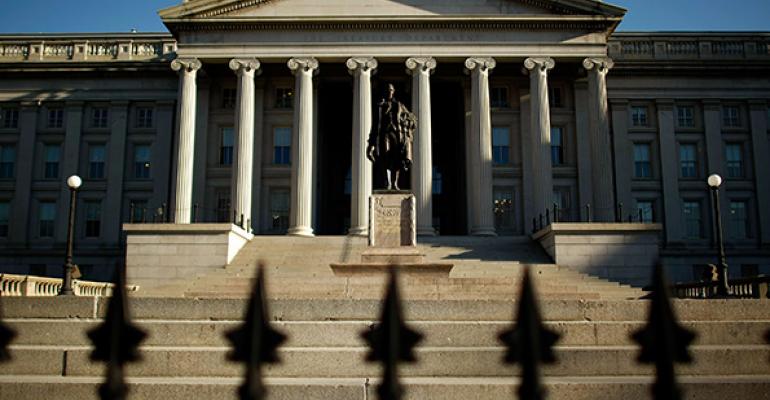By Liz Capo McCormick and Alexandra Harris
(Bloomberg) --Nobody doubts America will make good on its debts.
Yet if Congress fails to lift the debt ceiling in time, what’s known as a “technical” default -- one that merely delays interest and principal payments -- would be on deck for the $14.1 trillion Treasury market, presenting a potentially dizzying array of complications.

Bond-market industry groups aren’t waiting to see how it plays out. They’re fine-tuning prior blueprints for how to handle affected securities so trading is uninterrupted and the plumbing of a crucial market for short-term financing still functions. Still, nailing down the back-office preparations doesn’t alleviate concern that investors may shun Treasuries amid the upheaval.
“It would be very disruptive to the Treasury market,” said Ward McCarthy, chief financial economist at Jefferies LLC, who’s been watching markets for more than 30 years. “If it comes to this, we’d expect the U.S. to be downgraded again and it would cast a very large shadow over the U.S. as being the gold standard of bond markets.”
S&P Global Ratings cut the U.S.’s top rating amid the 2011 debt-limit standoff and warned last week that failure to increase the debt ceiling would likely be more damaging for the economy than the collapse of Lehman Brothers Holdings Inc.
Mnuchin’s Promise
Treasury Secretary Steven Mnuchin reiterated last week that it’s critical to raise his borrowing authority by Sept. 29, and said he’s confident lawmakers will do so in time. The prospect of a deal may become entangled with efforts to address relief aid for Hurricane Harvey.
“The president and I believe that it should be tied to the Harvey funding,” Mnuchin said of the debt-cap increase on “Fox News Sunday.”
House Speaker Paul Ryan told the Milwaukee Journal Sentinel on Sept. 1 that Congress has until October to act on the debt ceiling, and also said the country won’t default.
Investors have been down this road before, but a technical default would lift the showdown to another level, with ripple effects in the following areas.
Treasury Auctions
Past Treasury secretaries, pushed to the limit of the extraordinary measures they can tap to stay under the debt limit, have resorted to postponing debt sales. This year, analysts say two-, five- and seven-year note sales in late September are at risk.
In 2015, then-Secretary Jacob J. Lew delayed a two-year auction. In 1996, Robert Rubin postponed sales of two- and five-year notes, as well as a one-year bill.
Repo Fix
The Securities Industry and Financial Markets Association and the Treasury Market Practices Group have done plenty of work to prepare for past debt-ceiling episodes. They’re dusting off those plans now, laying the groundwork for processing debt with delayed payments. That would allow the securities to be cleared in the $1.8 trillion market for tri-party repurchase agreements.
Even so, lenders will likely view this collateral as riskier, leading them to offer less cash in repo deals backed by the securities and triggering margin calls, according to JPMorgan Chase & Co. That scenario would risk worsening Treasury-market liquidity already damaged by investor unease surrounding any technical default.
Debt Costs
Rates on Treasury bills due around the X-date have already risen as investors shun the debt. In the event of an actual technical default, yields on even longer maturities could increase as well, ultimately lifting the government’s financing costs.
The added tab to taxpayers from higher yields in the 2013 debt-cap episode reached as much as $70 million, while in the 2011 episode, which resulted in a U.S. downgrade, costs rose by $1.3 billion, according to the Government Accountability Office.
Money-Fund Outlet
There is one post-financial crisis change that may help limit the fallout. It’s that money funds -- key buyers of Treasury bills -- have a new alternative for parking their cash, in the form of the Fed’s overnight reverse repo agreements. The RRPs, as they’re known, will give funds looking to avoid government debt a safe option with nearly unlimited availability.
First introduced in September 2013, these deals weren’t really a viable option during the previous debt-limit showdown. That’s because few funds were able to participate and the Fed capped firms’ use at $1 billion daily. Now, there’s a $30 billion limit per entity and 136 counterparties, 102 of which are money-market mutual funds.
Even with all the advance preparations, a technical default still risks having a dire and lasting effect. That was the takeaway for observers back in 2013.
“Once Treasury has exercised the option to delay payments, investors will learn a lesson that cannot and will not be unlearned,” Paul Stevens, president of the Investment Company Institute, told a Senate Banking committee in October 2013, in the midst of that year’s impasse.
“That lesson is simple: Treasury securities are no longer as good as cash -- they carry a future risk of further missed payments,” he said. “That risk will be priced into the interest rates that investors demand and into traders’ reluctance to treat Treasuries as liquid.”
Attatched Media
To contact the reporters on this story: Liz Capo McCormick in New York at [email protected] ;Alexandra Harris in New York at [email protected] To contact the editors responsible for this story: Boris Korby at [email protected] Mark Tannenbaum, Greg Chang

